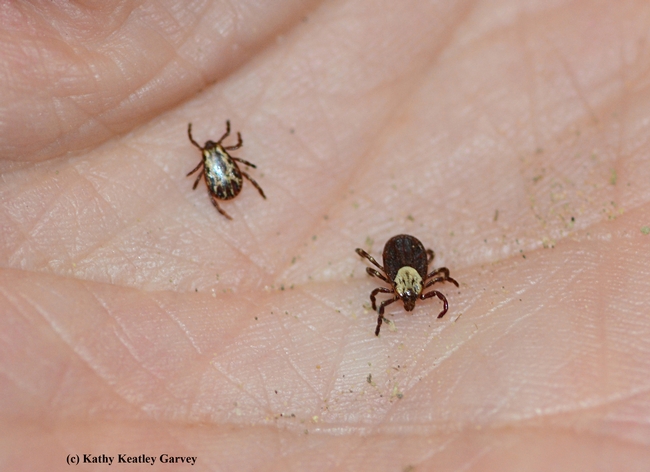
Ticks can do that to you.
I never think about ticks during the holiday season, but a news release from the University of Cincinnati about how “Hungry Ticks Work Harder to Find You” piqued my interest--and memories of the day our family inadvertently “collected” a total of 14 ticks.
But first, the news release about this fascinating research...
UC writer Michael Miller described ticks as “hardy little brutes that can go as long as a year without a meal,” and that “the hungrier ticks are, the harder they try to find you or other hosts.”
Biologist Andrew Rosendale, lead author of the study and UC adjunct assistant professor of biology, said that starved ticks are more likely to look for a host and they're more likely to attach to the host longer “which provides a greater opportunity to transmit diseases.”
Ticks, as you know, feed on blood. They feed on blood as larvae, nymphs and adults. Ticks "spend most of their lives on the ground in tall grass, patiently biding their time for a victim and presumably ignoring their rumbling stomachs,” Miller wrote in his news story.
Fact is, ticks are very good at waiting, waiting to ambush you. They can reach near starvation because their metabolism slows. “In the absence of any host cues, they go into a dormant state where they don't move around a lot,” UC biology professor Joshua Benoit related.
Then there's "questing."
Miller explained that “In the wild, adult ticks explore the undergrowth and climb tall grass. They reach out with the claws on their forelegs, a behavior called questing, to snag an animal's fur or your denim jeans. Then they burrow into their hosts with mouthparts shaped like ratchets that keep them in place....In the lab, UC researchers stimulated the ticks' questing behavior by breathing into identical glass cylinders. (Ticks can sense carbon dioxide so they know when a possible meal is close at hand.) Biologists recorded differences in activity between just-fed ticks and starving ones. They found that starved ticks had higher activity levels and increased questing behavior than recently fed ones.”
Miller also pointed out that “after three months without food, a tick's metabolism actually increases significantly--by as much as 100 percent--and remains at this higher rate for weeks in association with its increased activity.”
“Likewise, UC biologists found that genes related to immunity were activated by starvation, which could be another survival mechanism," Miller wrote. "Animals that feed on blood must have a immune system capable of fighting bacteria and other microorganisms. By activating genes associated with immunity, ticks might be preparing for an imminent meal.”
Another discovery: the UC biologists found that genes associated with a starved tick's salivary glands activated those glands. “Saliva is known to help ticks drink more blood more quickly, a useful ability when you're clinging precariously to a moving animal in thick brush," Miller wrote. "The sticky saliva also helps cement the tick to the host."
Added Rosendale: “The more they were starved, the more they were priming themselves for that next blood meal.”
And about our family's “tick-collecting trip?”
It was April 14, and the two of us and two dogs were walking through a tall grassy area in Sonoma, enjoying the poppies, fresh vegetation and the springlike weather. When we returned home, we found a total of 14 ticks: 13 either in or on our hair, skin or clothing, and one attached to our Chihuahua mix.
Lynn Kimsey, director of the Bohart Museum of Entomology and professor of entomology at UC Davis, identified them as Dermacentor occidentalis (Pacific Coast tick). Thankfully, this species does not transmit Lyme disease.
We never thought about wearing a repellent that day, but a spokesperson at the Sacramento-Yolo Mosquito and Vector Control District's booth at UC Davis Picnic Day last April said she sprays her clothing with "Off" before she dons the clothing and ventures out into tall grass or brushy areas--or where ticks are likely to be.
She handed out brochures, but you can also read more about ticks (and lyme disease) on the Sac-Yolo website at https://www.fightthebite.net/ticks-and-lyme-disease/ or download the brochure at https://www.fightthebite.net/download/brochures/Ticks.pdf
The brochure indicates that "Ticks do not fly, jump, or fall out of trees! They are usually found in grassy areas, in brush, or in a wooded area. They wait on the tips of vegetation for a human or other animal host to pass by. As the host brushes against it, the tick makes contact, looks for a suitable location, and begins the feeding process."
And "contrary to popular belief, ticks DO NOT embed their heads in skin. Ticks are equipped with mouthparts adapted to penetrate and hold fast in the skin of its host. Additionally, they secrete a cement-like material that helps them stay attached to their host."
Yes, they do. One tick embedded itself in my ear.
I think it must have been one of near-starvation ticks with ultra sticky saliva...
Attached Images:
